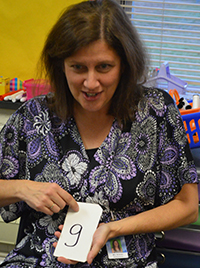Collaboration is the way forward, say leaders of West Michigan’s Reading Now Network. Teachers teaching other teachers, more staff with reading expertise, and learning from those whose students are excelling, are all actions the region’s schools are taking to change reading achievement numbers.
Dorothy VanderJagt, RNN field study member and director of Teaching & Learning at Kent ISD, said teachers presented best practices at the Fall Institute, share tips on the RNN Twitter feed and “are visiting other schools to dig deeper into those common traits of the high performers.”
Educators from the Field Study Team are working directly with schools that need to make big gains, with administrators who set a goal to meet or exceed their peers in two years.
The work of Reading Now Network, a collaborative effort to increase reading proficiency involving 100 districts in 13 counties, is well under way. It is paying off in districts like Kelloggsville, where additional staff and new techniques are helping students read in fun, new ways.
Common Traits Among Schools with High Reading Proficiency
Source: Reading Now Network |
Kyle Mayer, an RNN field study member andOttawa Area ISD assistant superintendent, said the project’s findings have prompted many schools to take action.
“Every day I come to work and I hear about something else happening because of Reading Now Network,” Mayer said.
The network was launched in the spring of 2014, examining best instructional practices at five West Michigan elementary schools with high reading success rates in order to implement them region-wide.
Schools studied ranged from urban to rural, with varying levels of poverty. They are: Brown Elementary in Byron Center, North Godwin, Lakeshore Elementary in Holland, Coit Creative Arts Academy in Grand Rapids, and Sunfield Elementary in Lakeview Community Schools.
Curriculum leaders visited the schools (all of which scored high on third-grade reading MEAP tests), over the course of an eight-month study to identify why they were high performers.

One District’s Response
Tammy Savage, Kelloggsville Public Schools director of instruction, added two new reading instructional specialists this year, partly in response to information she learned at a spring RNN symposium.
Specialists Suzanne Schmier and Janna Schneider joined Sue Lathrop this fall to work full-time in the district’s three elementary schools. For the past few years, Lathrop was spread among all three schools, assisted by paraprofessionals.
The goal is to create a consistent, structured, very focused reading intervention program for students, Savage said. Teachers are using data to identify students’ needs.
Learning how to implement best practices is taking shape in different ways, said Mayer, the field study member. A sold-out event at Kent ISD in November brought together 200 area principals to learn from leaders of the schools originally studied for their reading practices.
“Principals can go back and start making immediate changes based on what they learned,” Mayer said.
Three schools where educators are not satisfied with reading results have been named “lab” schools. Field study members are working with them on instructional practices to help them improve their results, Mayer said. The schools represent three counties and have varying demographics, including differing income levels and locations.

A Peek Into a Classroom
In Kelloggsville, reading sessions are a multi-sensory experience. Students see, touch, hear, and even smell and taste the words — when letters double as licorice sticks.
During a recent class with Shmier, West Kelloggsville Elementary students acted out what they were reading. A sentence about a girl who hurt her lip had them pouting. Another about flying kites had them pretending to send them soaring.
“That’s fun!” said second-grader Alyssa VanVolkinburg. “It’s fun to make the motions.”
Students wrote letters on plastic tablets, velvet and laminate; they spelled out words with their fingers and while touching different spots on their arms. They talked vividly about what they read.
The coaches, all longtime Kelloggsville teachers, were also recently trained in Orton-Gillingham methodologies, which promote multi-sensory learning.

Tools Are Available
In-depth videos with interviews from administrators, teachers and students taken at the school, are available on the Reading Now Network web site.
One thing made clear from the field study was that high-performing schools are “data-driven,” meaning they constantly used test scores and other data to improve instruction – often on a daily basis. Teachers are being trained to easily access data through an Edify software system, which Kent ISD first developed.
Kent ISD received a state grant to develop an early literacy alert and intervention system. The intent is to equip teachers participating in RNN with lots of resources to help students reading below grade level. These resources will be offered free of charge to the schools and service agencies within the Reading Now Network.
CONNECT









